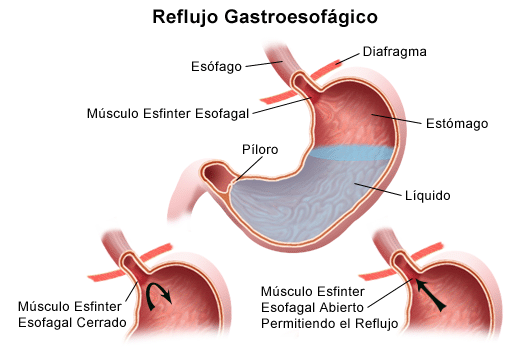Obesity with Gastroesophageal reflux
Artículo de Interés
este artículo ha sido calificado por 1230 personas a través de buscadores y redes sociales
El reflujo gastroesofágico ocurre cuando el EEI no funciona como corresponde y permite que el ácido retroceda y queme la porción inferior del esófago. Esto irrita e inflama al esófago, y ocasiona la sensación de acidez, y con el tiempo puede incluso dañar el esófago.
🔍 ¿Qué Ocasiona el Reflujo?
⭐ Al comer, los alimentos pasan de la boca al estómago a través de un tubo que se llama esófago. En el extremo inferior del esófago hay un pequeño anillo muscular que se denomina esfínter esofágico inferior (EEI).
⭐ El EEI funciona como válvula de una vía, al permitir que pasen los alimentos hacia el estómago. Normalmente el EEI se cierra de inmediato después de tragar a fin de impedir que retrocedan los jugos gástricos —que tienen un alto contenido de ácido— al esófago.
⭐ El reflujo gastroesofágico ocurre cuando el EEI no funciona como corresponde y permite que el ácido retroceda y queme la porción inferior del esófago. Esto irrita e inflama al esófago, y ocasiona la sensación de acidez, y con el tiempo puede incluso dañar el esófago.

What Causes Reflux?
When you eat, food passes from the mouth to the stomach through a tube called the esophagus. At the lower end of the esophagus there is a small muscular ring called the lower esophageal sphincter (LES).
The LES works as a one-way valve, allowing food to pass into the stomach. The LES is normally closed immediately after swallowing to prevent gastric juices - which are high in acid - from backing up into the esophagus.
Gastroesophageal reflux occurs when the LES does not work properly and allows acid to back up and burn the lower esophagus. This irritates and inflames the esophagus, causing a sensation of heartburn, and can even damage the esophagus over time.
What Factors Contribute to Reflux?
Some people are born with a sphincter (LES) that is naturally weak. However, for others, fatty and spicy foods, certain types of medications, tight clothing, smoking, alcoholism, vigorous exercise, or changes in body position (bending over or lying down) can cause the LES to relax and reflux to occur. A hiatal hernia (a common term for gastroesophageal reflux) can exist in many patients with gastroesophageal reflux, although it may not cause symptoms of heartburn.
Nissen Technique
Nissen fundoplication is the technique of choice to treat hiatal hernia, as well as the most common surgical technique for the treatment of gastroesophageal reflux, once medical treatment has failed
Surgical technique
In a fundoplication, the gastric fundus (the upper part) of the stomach wrinkles, or plica, around the distal part of the esophagus, thus remaining anchored to reinforce the occlusive function of the lower esophageal sphincter. The esophageal hiatus is further narrowed through sutures to prevent or treat concomitant hiatal hernias, in which the fundus is forced through the esophageal hiatus of diaphragm
Incision types of fundoplication.
In a Nissen fundoplication, also called a complete fundoplication, the fundus is folded over the entire circumference of the esophagus, 360 degrees. This operation is routinely performed laparoscopic. When used to relieve reflux symptoms in patients with delayed gastric emptying, it is frequently combined with pyloric surgery, either pylorotomy or pyloroplasty.













